MARIANI’S
Virtual
Gourmet
December
25, 2016
NEWSLETTER
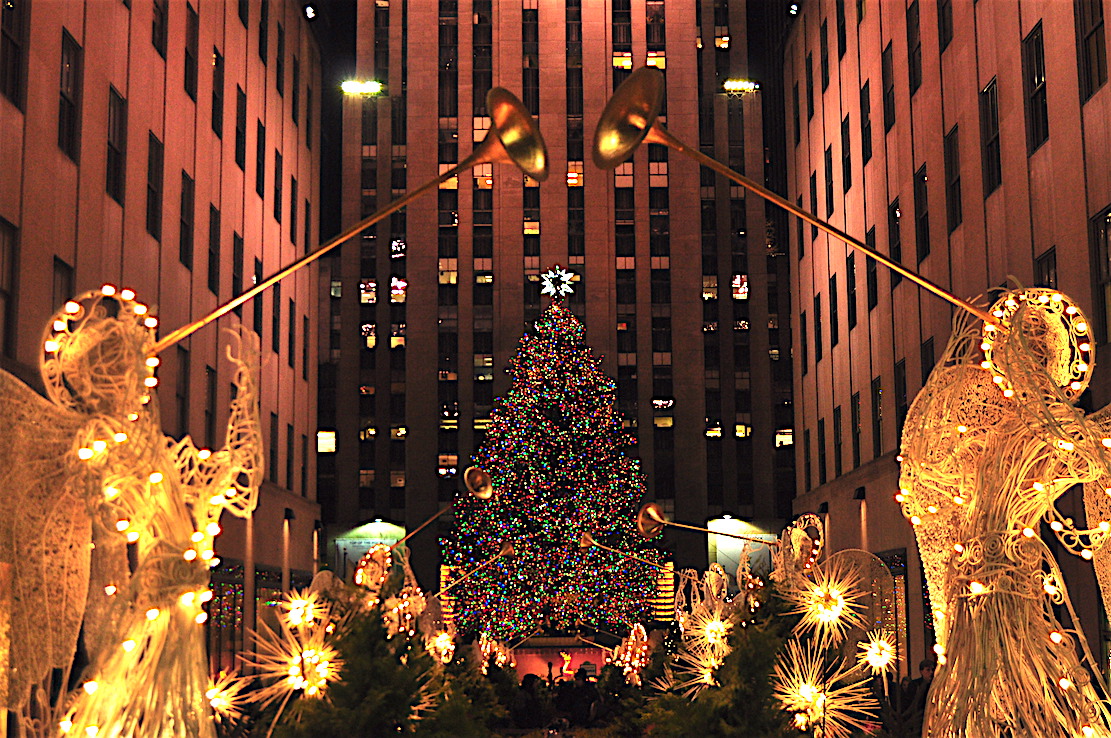
❖❖❖
IN THIS ISSUE
VENICE MAINTAINS ITS MAGIC
By Christopher Mariani
NEW YORK CORNER
LITTLE FROG
By John Mariani
NOTES FROM THE WINE CELLAR
THE WINES OF FRANCIS FORD COPPOLA
BY Brian Freedman
❖❖❖
VENICE MAINTAINS ITS MAGIC
By Christopher Mariani
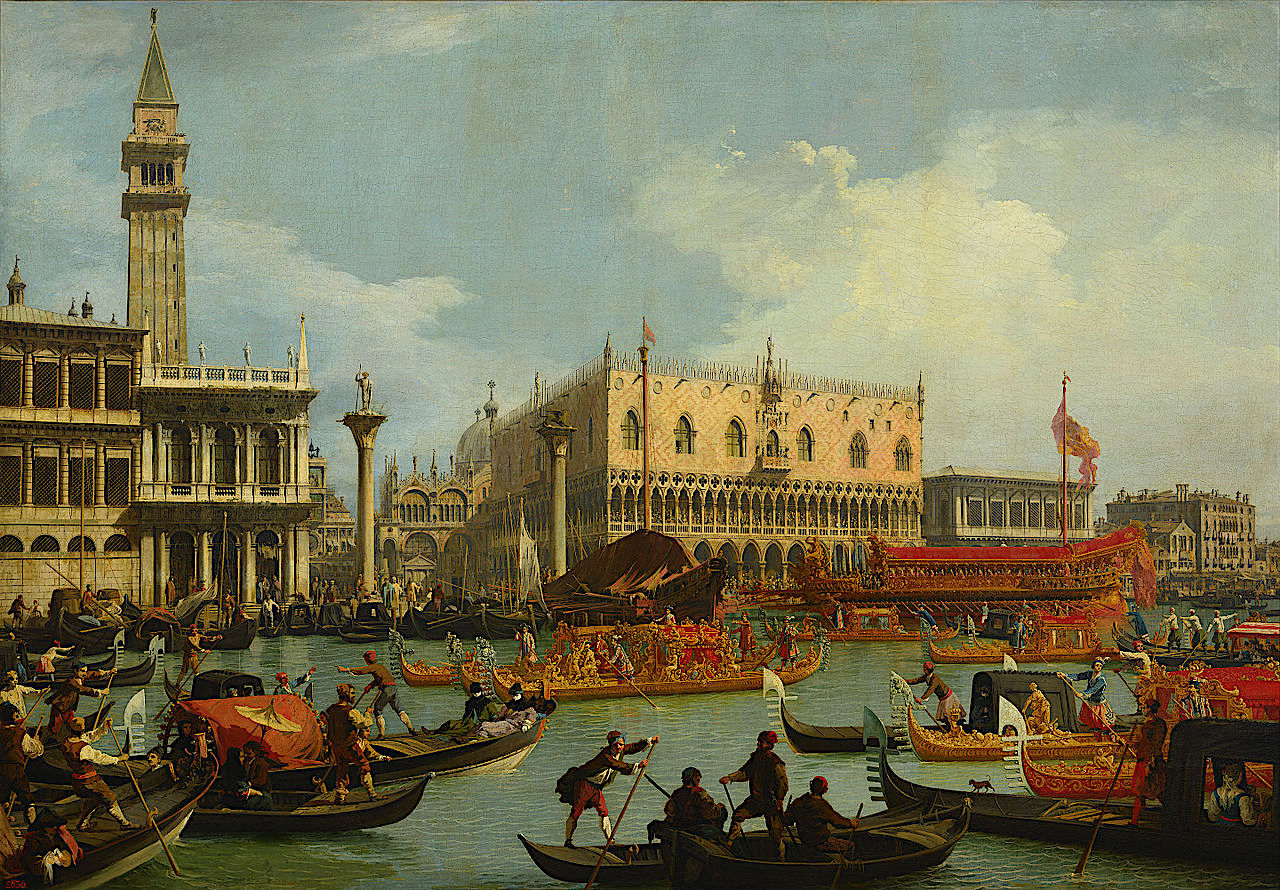
"The Return of the Bucintoro to the Molo on Ascension Day" by Canaletto (1729-32)
For much of its history
Venice was the mighty ruler of the Eastern
Mediterranean, yet it was lovingly called La
Serenissima. Today
tourists rule Venice simply by outnumbering a
dwindling number of residents.
"Sempre crolla ma non cade"
is a Venetian proverb that means, the city is
always collapsing but never fallen, for the city
survives every assessment of its imminent demise
as the waters of the Adriatic flow in and out of
its lagoons, lapping over into the streets and up
to the windows, regularly flooding the Piazza San
Marco.
To Byron the city was a reverie
and revelry--"the greenest island of my
imagination"; Henry James thought it a "vast
museum"; Shelley called its "Earth's nursling,"
and Truman Capote said the city was like "eating
an entire box of chocolate liqueurs in one go." And the
magic is still there, from San Marco to the
meandering narrow streets leading from it.
And now in winter, it is
quieter, prices drop in the hotels and
restaurants. Venice breathes a little more slowly.
Here are three uniquely beautiful places to get a
sense of Venice's grandeur.
BELMOND HOTEL CIPRIANI
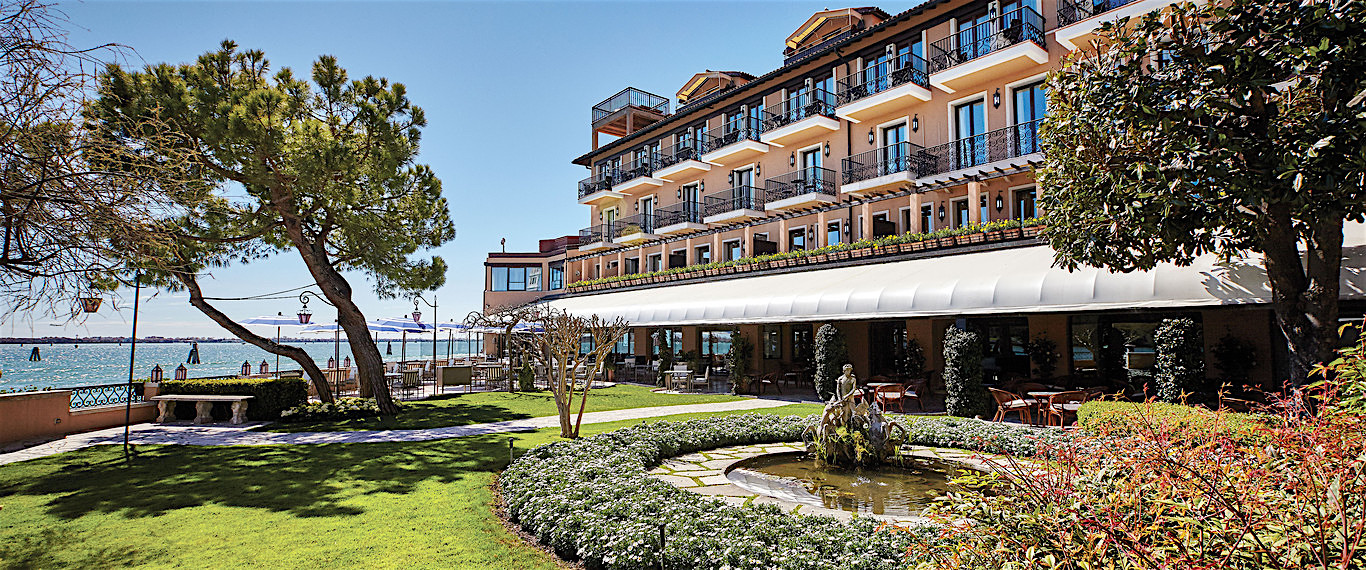 Having just spent seven days at sea stopping
throughout Italy, the Greek islands and Croatia
onboard Costa Cruises’ Costa
Deliziosa I was in need of a change of
scenery. We docked at the Maritimma terminal near
the Piazza Roma
in Venice, Italy and immediately made our way to
the first available water taxi and when asked
where to, I smiled and said, “Hotel Cipriani.”
Having just spent seven days at sea stopping
throughout Italy, the Greek islands and Croatia
onboard Costa Cruises’ Costa
Deliziosa I was in need of a change of
scenery. We docked at the Maritimma terminal near
the Piazza Roma
in Venice, Italy and immediately made our way to
the first available water taxi and when asked
where to, I smiled and said, “Hotel Cipriani.”
“Si signore,”
replied our driver. And off we traveled across the
choppy lagoon towards the small island of
Giudecca, across from the largely man-made island
of Venice itself. Our
taxi slowed as we turned a corner and in the
distance we saw the hotel’s iconic blue and white
umbrellas offering cover to guests enjoying an
aperitif or an afternoon espresso. I figured there
was no better place to spend 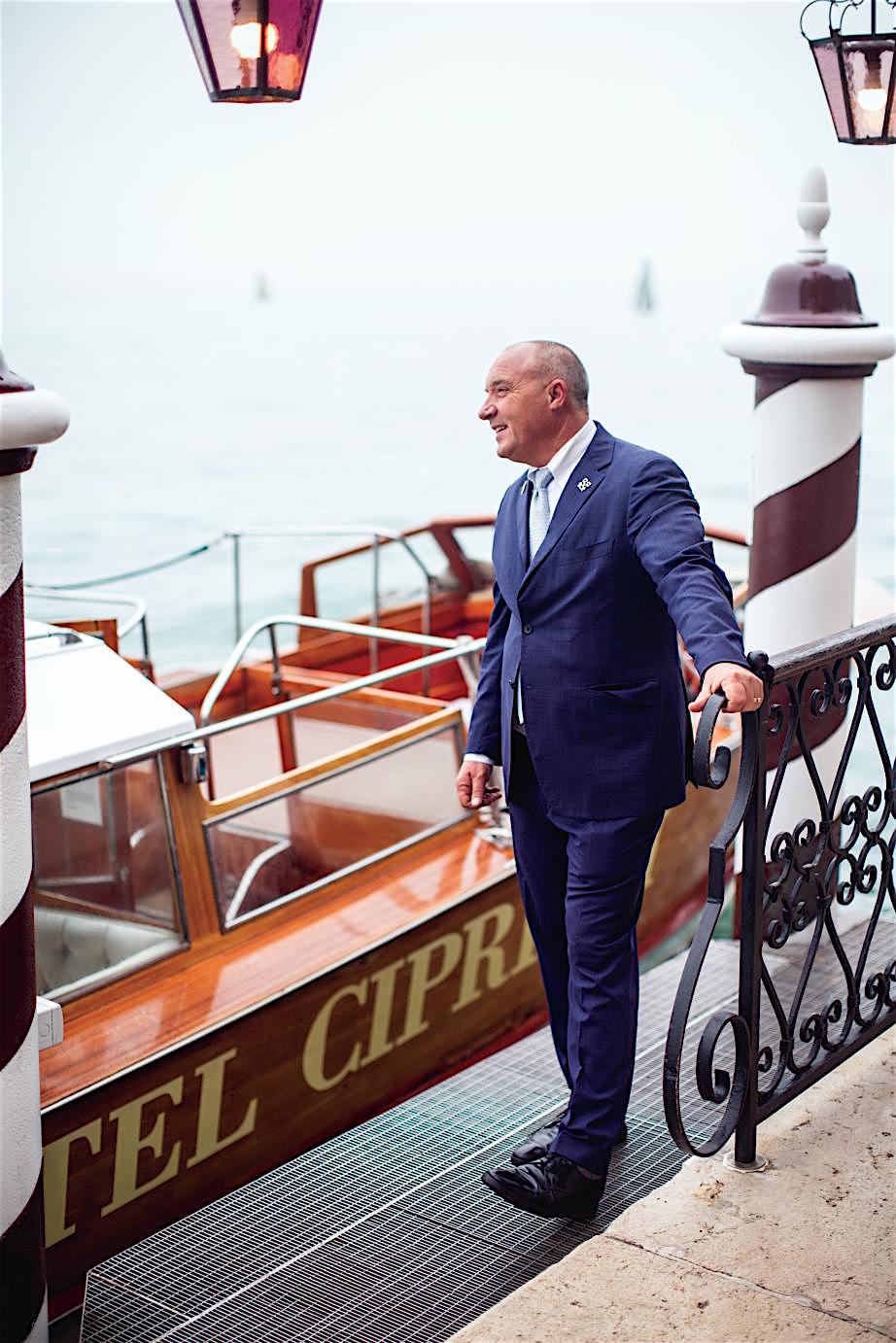 one of the final nights’
of my honeymoon than at the Belmond Hotel
Cipriani. My wife seemed to
agree.
one of the final nights’
of my honeymoon than at the Belmond Hotel
Cipriani. My wife seemed to
agree.
As our boat pulled up to the
hotel dock we were greeted by a pair of sturdy
hands which gently grabbed my wife’s arm to help
her off the boat. We were led through the hotel’s
well-groomed entrance and once inside approached
the check-in counter where our presence was
immediately acknowledged. Before introducing
myself our host looked up and said, “Welcome
Signore Mariani.” I knew from that moment on we
would be very well taken care of.
Hotel Cipriani welcomed its
first guests in 1958 and was instantly recognized
as one of the city’s premiere hotels. Owner
Giuseppe Cipriani who also opened Venice’s famous
Harry’s Bar on Calle
Vallaresso, known for its creation of the
bellini cocktail, was a
man who believed his patrons should be treated to
the absolute best accommodations possible. That
same tradition is currently upheld by General
Manager Giampaolo Ottazzi who has an impressive
résumé, working at a handful of other Belmond
properties along with the Hotel Villa La Massa in
Florence and the Grand Hotel Continental and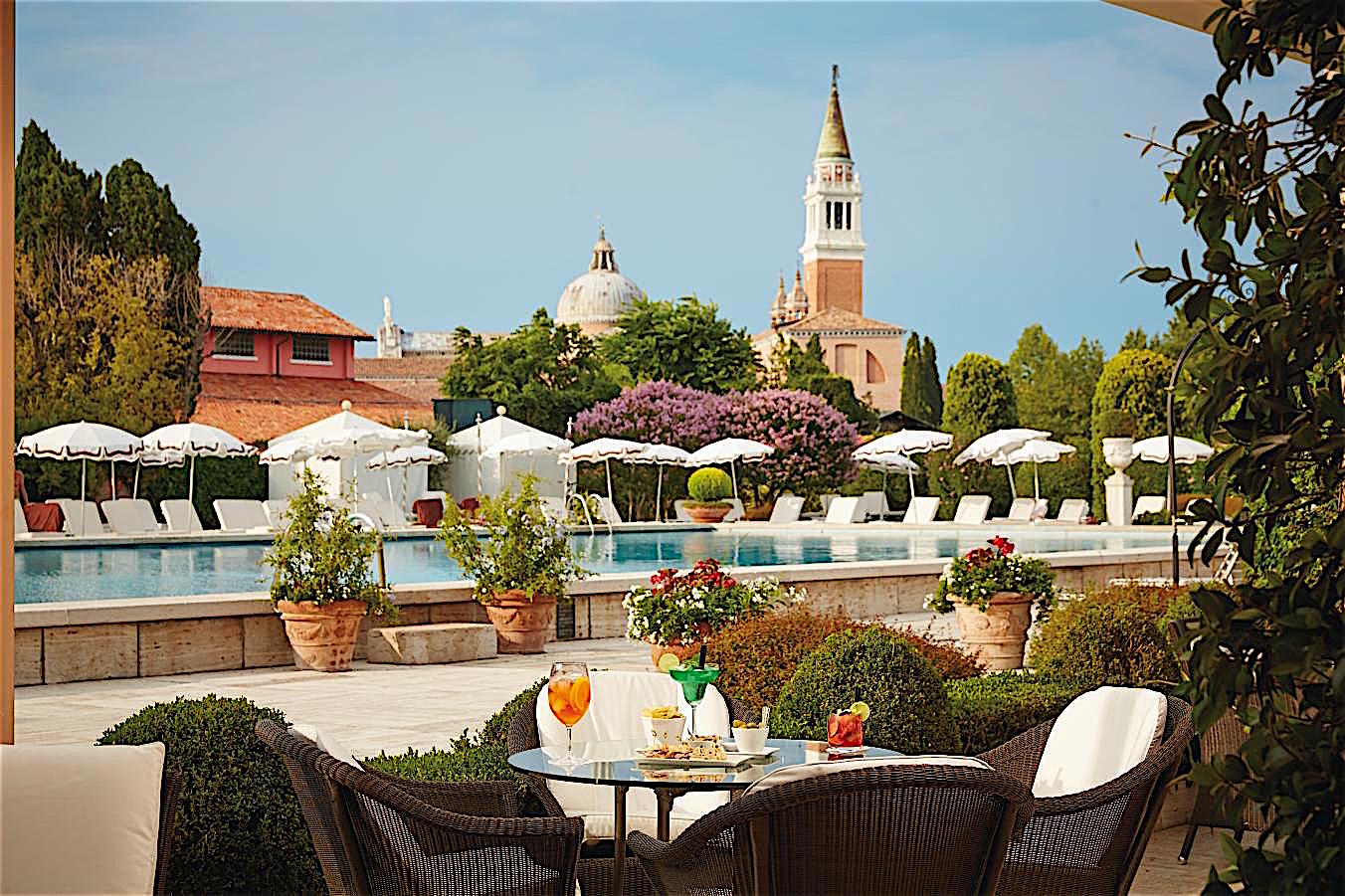 Park Hotel in Sienna.
Ottazzi was seen just about everywhere on property
during our brief stay. He is clearly involved in
every aspect of the hotel, its property and many
gardens.
Park Hotel in Sienna.
Ottazzi was seen just about everywhere on property
during our brief stay. He is clearly involved in
every aspect of the hotel, its property and many
gardens.
Our room was not quite ready so
my wife and I walked to the hotel’s Giabbiano
Poolside Bar (left)
for a couple of cocktails as we peered out at the
hotel’s Olympic-size salt water swimming pool, the
largest in all of Venice. The property’s
tranquility began to set in with the help of two
excellent cocktails made by head bartender Walter
Bolzonella, here since 1978. (Frequent
guest George
Clooney once jumped behind the bar to make a
cocktail for the staff at three in the morning,
now commemorated in a drink called the Bellanotte,
with lemon, vodka, bitters, and cranberry juice.)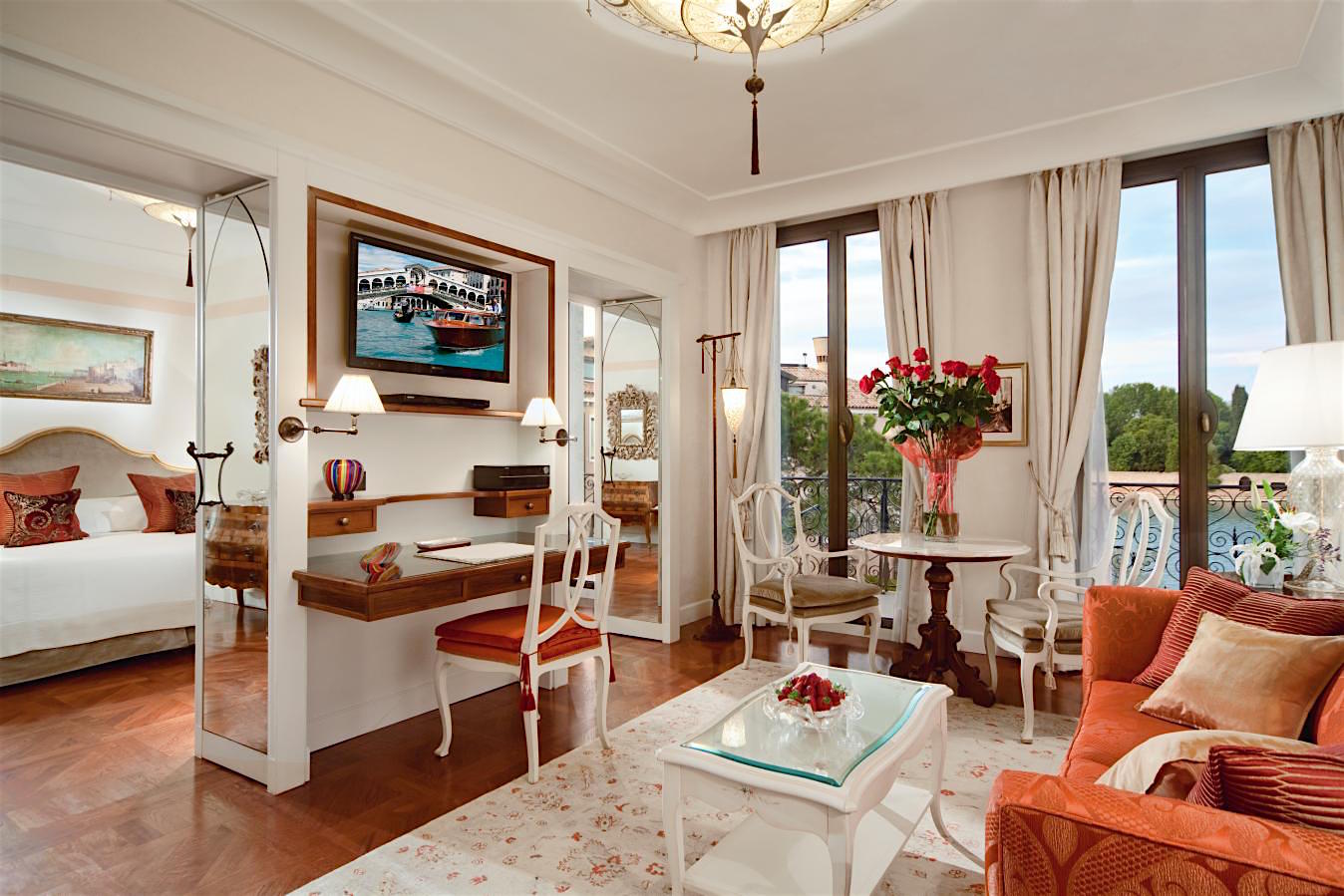
Shortly after we were escorted
to our suite, fitted with a quaint balcony
overlooking the lagoon, where we sat and leisurely
sipped two perfectly made espressos. Our deluxe
suite was draped in elegance from every selection
of furniture to the pristine lighting package and
gorgeous bedroom chandelier. The property has a
total of 25 rooms, 29 junior suites and 15 suites,
many of which have stunning views of the hotel’s
gardens. There is also the highly coveted and
highly expensive Palladio suite with a panoramic
view of the Venetian lagoon, its very own dock,
private swimming pool, intimate deck and
impressive marble bathroom the size of most hotel
bedrooms. (The hotel also offers a complimentary
shuttle service for its guests onboard their
all-wood passenger boat departing every twenty
minutes from the hotel dock to Saint Mark’s Square
and back.)
That evening we dined at Hotel
Cipriani’s Cip’s Club (below) which sits directly on
the water facing St. Mark’s. We began the evening
with two glasses of prosecco while admiring a
beautiful view of Venice lit up at night as a few
small motor boats quietly passed us by. The night
grew cold and just moments after my wife rubbed
her arms a manager arrived to the table with 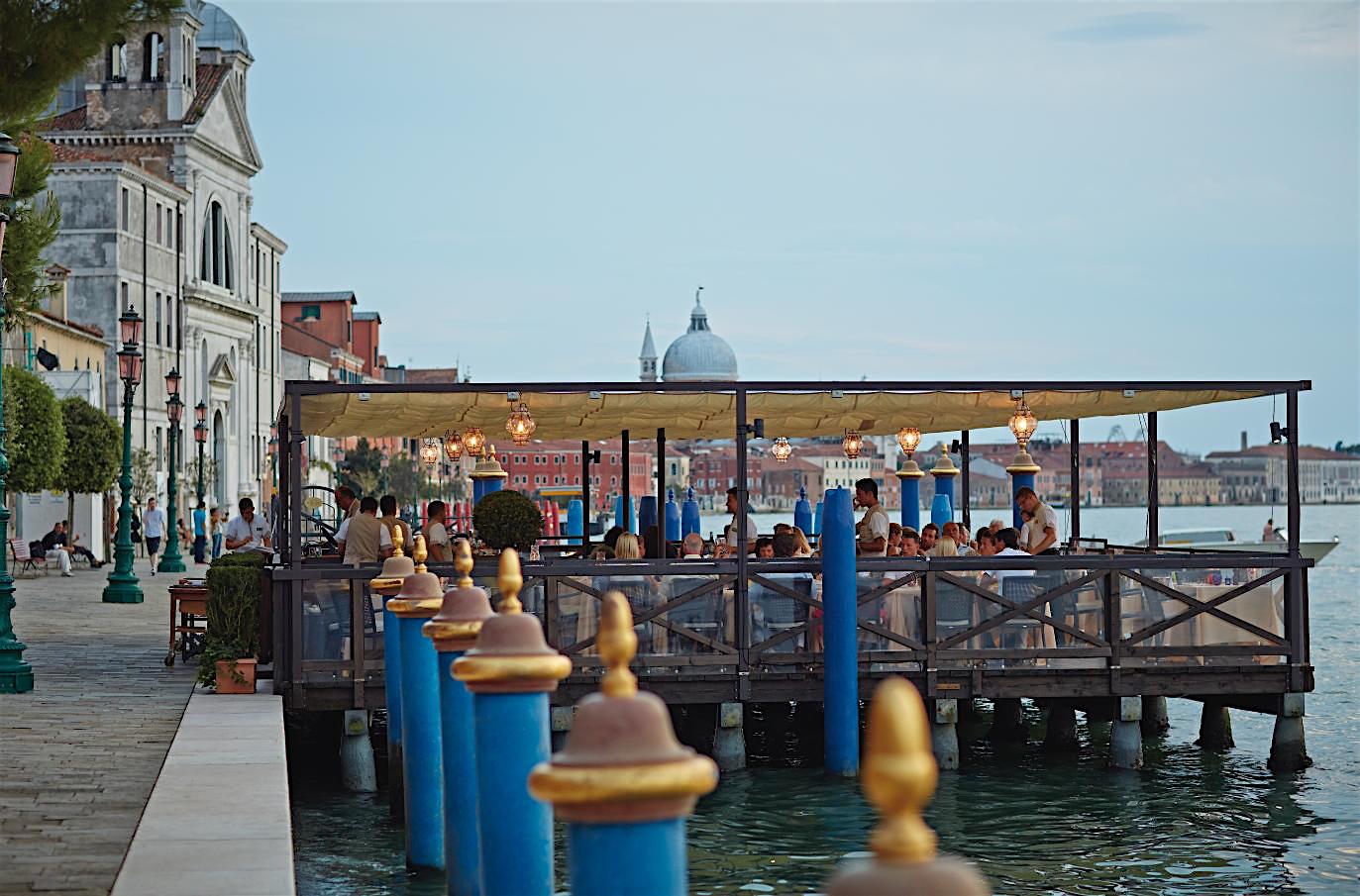 two shawls, one to wrap
around her body and the other to lay over her
legs. These are just a few of the gestures that
make Hotel Cipriani special. The service staff was
extremely attentive and clearly trained with an
emphasis on classic hospitality, a standard too
often lost in modern day dining.
two shawls, one to wrap
around her body and the other to lay over her
legs. These are just a few of the gestures that
make Hotel Cipriani special. The service staff was
extremely attentive and clearly trained with an
emphasis on classic hospitality, a standard too
often lost in modern day dining.
Chef Roberto Gatto has been
part of the Cipriani family since 1993 as chef de
partie
and now man’s the helm as head chef for Cip’s
Club, concentrating on Venetian and Italian
dishes. Start off with any of Gatto’s specialties,
including the thinly sliced prime beef carpaccio
with “Cipriani mayonnaise sauce,” or the simple
and delicious sautéed shrimp served over a small
mound of rice polenta drizzled with fabulous olive
oil. Pastas are large enough to share as a
mid-course and depending on the time of year can
be topped with thin shavings of either black or
white truffles, including the fat strozzapreti
with porcini
mushrooms
and rosemary. Entrees include daily fish specials
that can be either baked or grilled per the
guests’ request. I enjoyed a large veal Milanese
with a crispy coating and tender center served
with a salad of pachino tomatoes. We finished the
evening slowly sipping the remains of our wine
before heading back to our suite for a
well-deserved night’s rest.
The following morning we dined
inside the Oro dining room which offers a
magnificent complimentary breakfast buffet
abundantly displayed with an array of cheeses,
endless baked breads and pastries, thinly sliced
salami and prosciutto, yogurt and jams and freshly
squeezed juices. You can also order eggs, omelets
and coffee while seated. For lunch and dinner the
dining room transforms into the Michelin-star Oro
restaurant led by Executive Chef Davide Bisetto. I
did not have an opportunity to dine at Oro for
lunch or dinner.
We
reluctantly had to checkout after breakfast. We
were headed to the Hotel Bauer Palazzo for our
final night in Venice. The Cipriani’s staff was
kind enough to walk all of our bags to the Bauer’s
sister property on Giudecca island to ensure we
were taken care of up until the very last moment
of our stay, and from there the Bauer assumed the
same congenial task, moving our bags across the
Grand Canal. There are few hotels I have ever
stayed at that embrace the kindness and geniality
of Venice’s Hotel Cipriani.
Grazie.
HOTEL BAUER PALAZZO
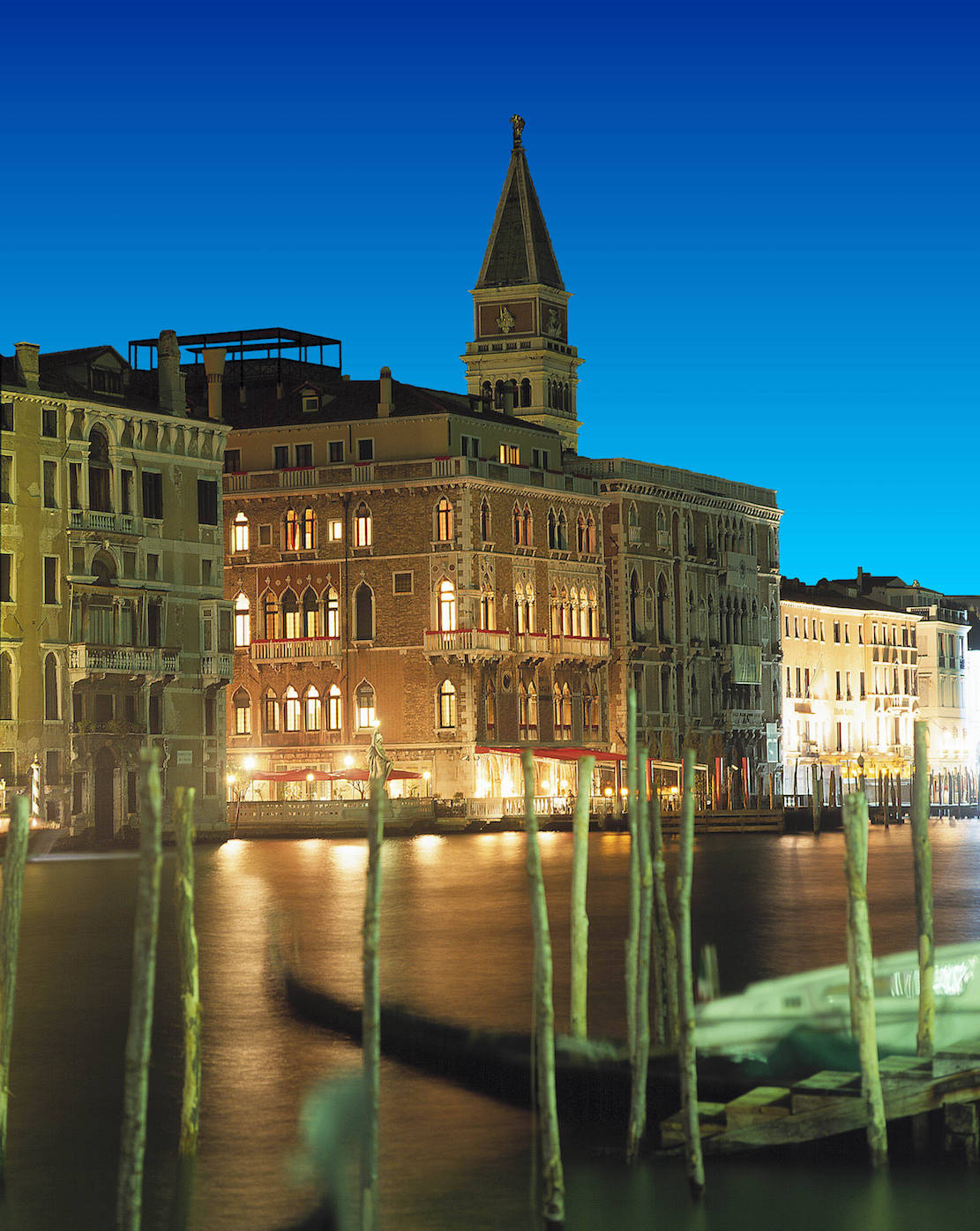 Another
first-rate Venetian hotel is the Bauer Palazzo
located in the heart of the city just a few blocks
from Saint Mark’s Basilica. The hotel sits
directly on the water at the mouth of the Grand
Canal with gorgeous views of the Punta Della
Dogana art museum just across the lagoon. Enter
from the street or the hotel’s private dock where
you can see an outside terrace filled with guests
dining at De Pisis restaurant if the weather
permits.
Another
first-rate Venetian hotel is the Bauer Palazzo
located in the heart of the city just a few blocks
from Saint Mark’s Basilica. The hotel sits
directly on the water at the mouth of the Grand
Canal with gorgeous views of the Punta Della
Dogana art museum just across the lagoon. Enter
from the street or the hotel’s private dock where
you can see an outside terrace filled with guests
dining at De Pisis restaurant if the weather
permits.
I say this because twenty years
ago my father brought me here and while dining
outside a sudden rush of torrential rain came down
upon us swelling the hotel’s red umbrellas with
water that in moments would collapse onto the
guests. We were quickly ushered inside by the
hotel’s staff where we pleasantly finished our
lunch, all done with a nonchalance that indicated
this was not the first time they needed to save a
passel of guests from impending disaster. It was
pure Italian sprezzatura—the
art of concealed art.
The original hotel, an 18th
century palace, opened
in 1880 and was known as the Bauer-Grunwald,
operated by Julius Grunwald, a young Austrian who
married the daughter of Mr. Bauer. The two quickly
partnered and went into business opening the hotel
together. Today
the property is run by Chairman and CEO Francesca
Bortolotto Possati, granddaughter to Arnaldo
Bennati who bought the hotel in 1930, and it has stayed
within the family ever since. Today the hotel
still holds the look and feel of its 18th
century roots blended with every modern day
amenity a guest could ask for, including
dependable, free Wi-Fi.
Over the past 20 years the
hotel has seen major renovations, and if you take
a quick boat ride across the lagoon to the Bauer’s
sister property, the Palladio Hotel, you can
avail yourself of a full-service spa experience.
The Palladio Hotel has a much more contemporary
feel and is located next door to Hotel Cipriani on
Giudecca Island. 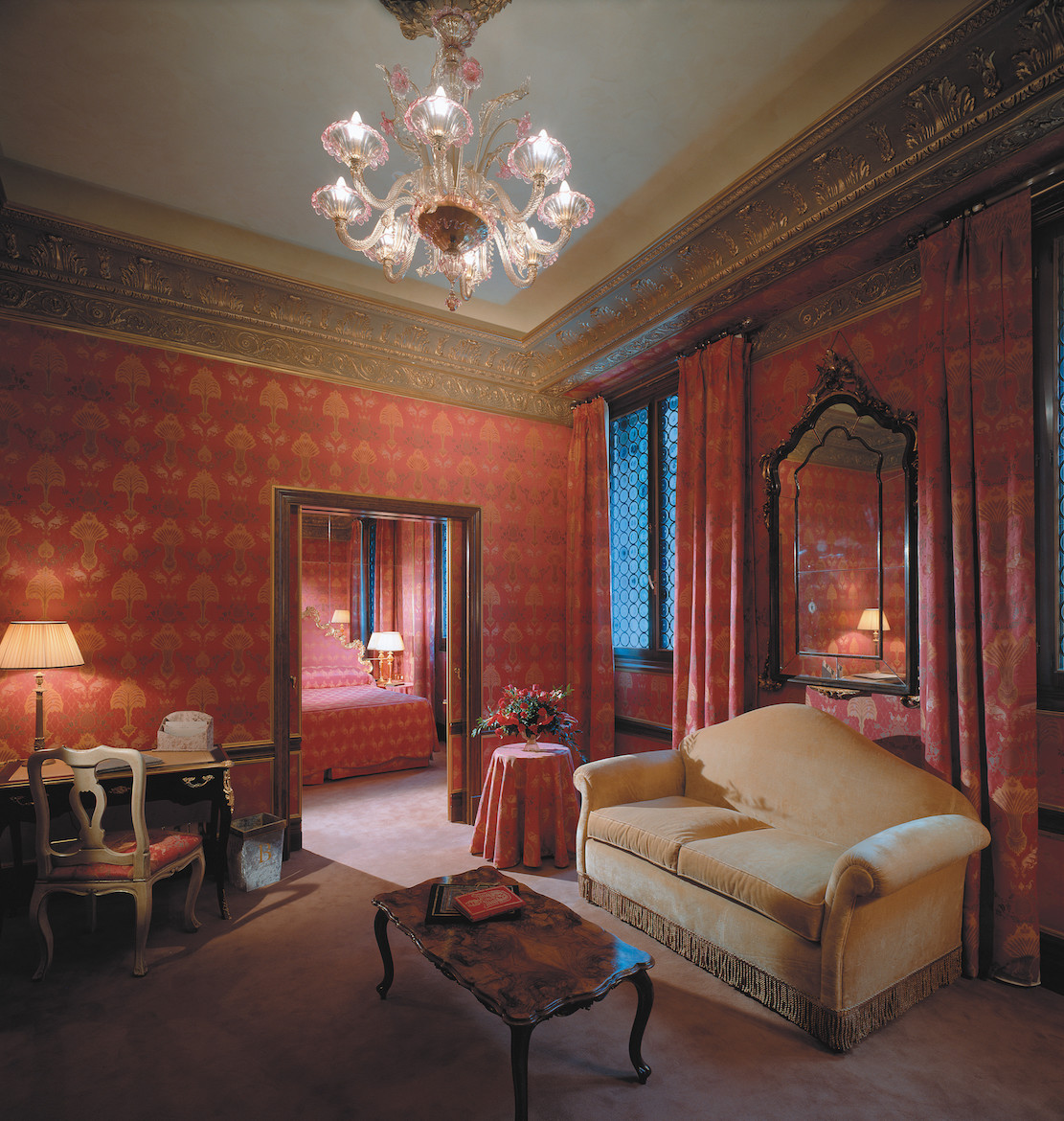
Rooms
at Palazzo are lavishly decorated with an Old
World feel. Beautiful stenciled designs and
patterns coat the walls and high ceilings,
doorways are ordained with dark wood moldings,
gorgeous thick oak-wood dressers fill the living
space and most of the rooms have grand windows
with terrace views. There is a true sense of
opulence that permeates the interior of the hotel
with a genuine attention to infinite detail.
De Pisis Restaurant can be found on
the hotel’s first floor next to the concierge
desk. Like the entire hotel the dining room’s
decor is a statement of Venetian beauty and
sophistication, from its Murano glass chandeliers
and rococo mirrors that reflect the soft light of
the lagoon to the rich fabrics on walls and
seating.
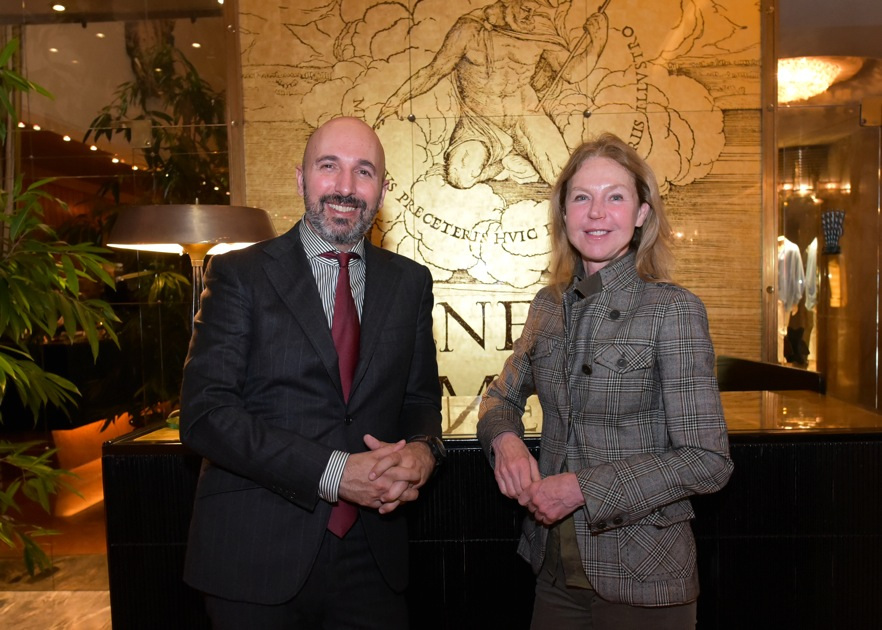 Signora
Possati recently brought in Michelin star-rated
chef Andrea Ribaldone (left) to oversee and direct all
food services within the hotel, and his influence
is clearly apparent throughout the menu. Alessio
Loppoli is the hotel’s resident chef, responsible
for the day-to day operations and menu execution.
Signora
Possati recently brought in Michelin star-rated
chef Andrea Ribaldone (left) to oversee and direct all
food services within the hotel, and his influence
is clearly apparent throughout the menu. Alessio
Loppoli is the hotel’s resident chef, responsible
for the day-to day operations and menu execution.
We
began our meal with two well-made Negronis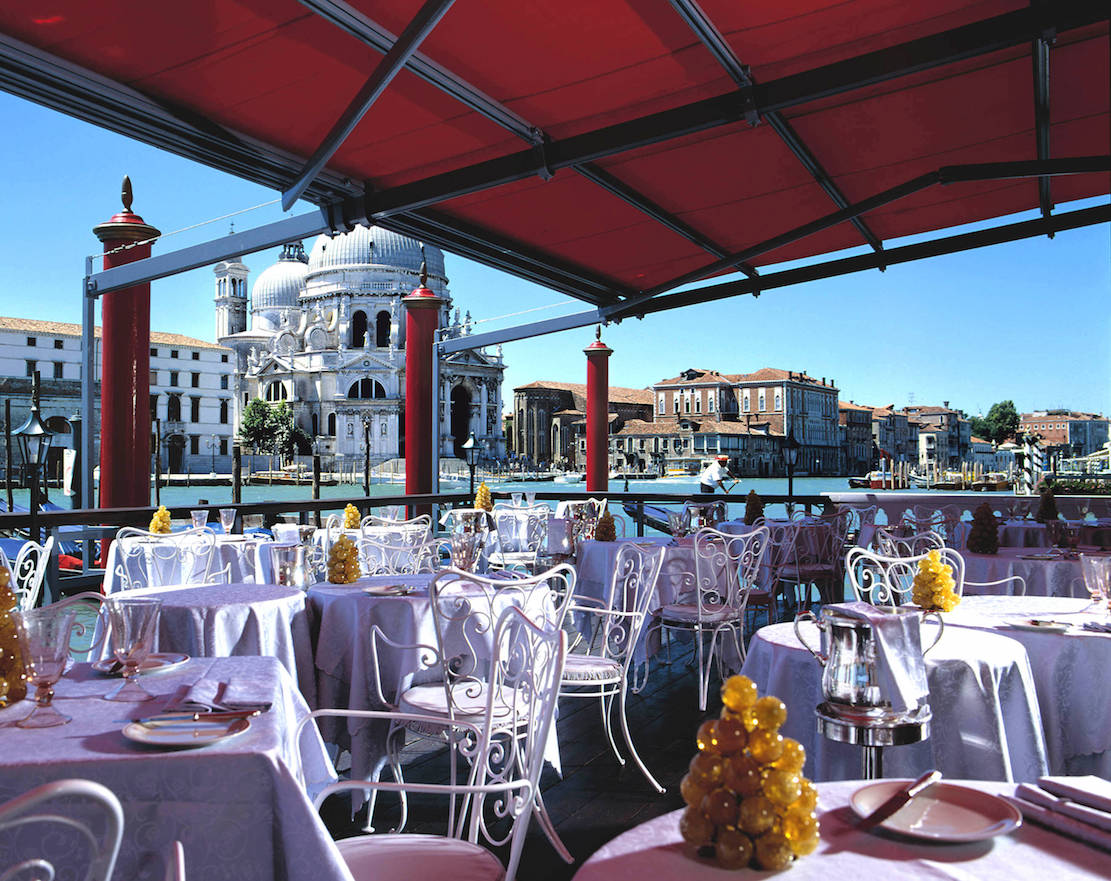 while
enjoying a view of the Chiesa di Santa Maria della
Salute church across the water. For starters try
the grilled octopus served with borlotti beans,
salami and olives or the beef carpaccio topped
with porcini mushrooms and Asiago cheese. Do not
miss out on the pastas which can be ordered either
as an entrée or a mid-course. There was a savory
ravioli filled with chicken, Parmigiano-Reggiono,
cream and saffron that my wife and I fought over
to the last piece.
while
enjoying a view of the Chiesa di Santa Maria della
Salute church across the water. For starters try
the grilled octopus served with borlotti beans,
salami and olives or the beef carpaccio topped
with porcini mushrooms and Asiago cheese. Do not
miss out on the pastas which can be ordered either
as an entrée or a mid-course. There was a savory
ravioli filled with chicken, Parmigiano-Reggiono,
cream and saffron that my wife and I fought over
to the last piece.
Housemade spaghetti
was cooked al dente, tossed with tender fresh
shrimp and a slightly sweet marinara sauce. Chef
Loppoli sources superb ingredients, and the dishes
he is producing are well-balanced, allowing for
each ingredient to be noticed and appreciated. The
food is filled with many layers of flavor and
texture but not one dish was overly complicated.
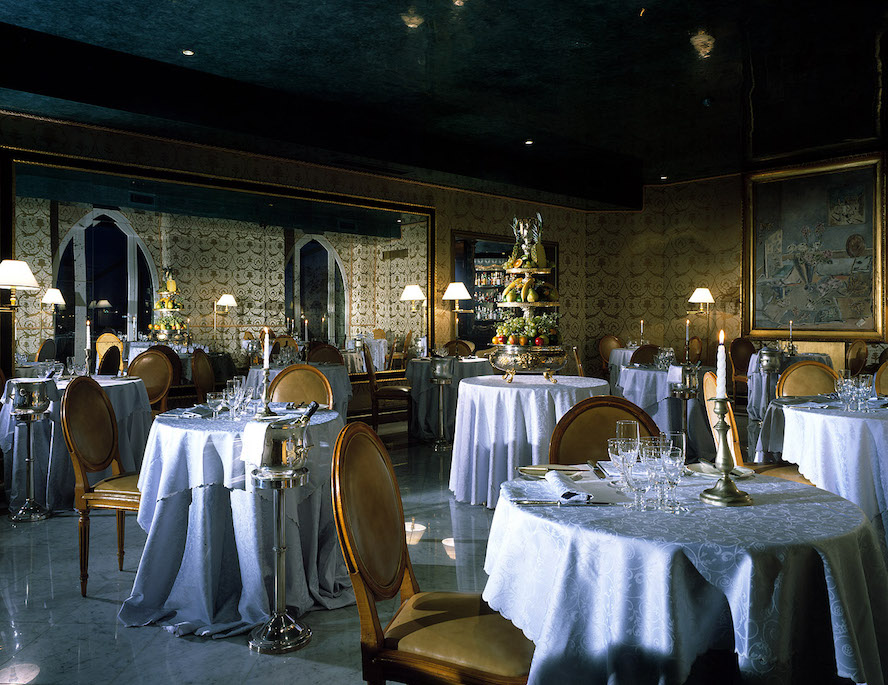 Entrees include
a terrific filet of turbot served with broccoli
and clams in a subtle garlic sauce. There is also
a roasted filet of veal served with crispy
croquettes and spinach, a very
rich dish well worth indulging in. Desserts were
clearly produced and plated by a talented pastry
chef who equally values the look and taste of each
dessert. My favorite was the “Oro Ciok” – a crispy
dacquoise cake with hazelnuts and bittersweet dark
chocolate topped with gold leaves.
Entrees include
a terrific filet of turbot served with broccoli
and clams in a subtle garlic sauce. There is also
a roasted filet of veal served with crispy
croquettes and spinach, a very
rich dish well worth indulging in. Desserts were
clearly produced and plated by a talented pastry
chef who equally values the look and taste of each
dessert. My favorite was the “Oro Ciok” – a crispy
dacquoise cake with hazelnuts and bittersweet dark
chocolate topped with gold leaves.
Prices are very reasonable for
this height of cuisine--$26-$39 for appetizers,
$22-28 for pastas, and $28-$36 for main courses.
We spent
the night in our suite but unfortunately had to
say goodbye to this truly memorable hotel as our
honeymoon came to a close. We checked out the
following morning and jumped into a water taxi
headed for Marco Polo Airport. With Venice in the
rearview mirror we smiled at one another knowing
we had made all the right decisions for what is supposed to be the
greatest vacation of a married couple’s life.
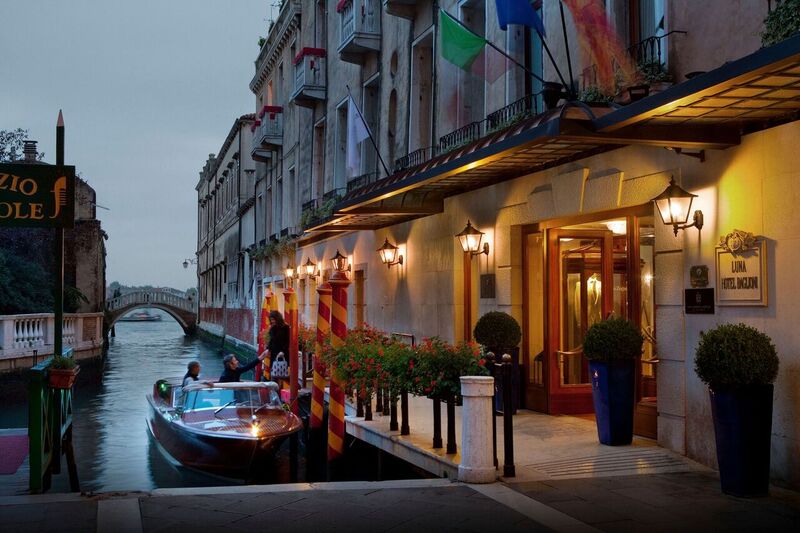
Venice
is by no means short on terrific restaurants,
but the city also has its fair share of mediocre
restaurants concentrated throughout the streets
surrounding Saint Mark’s Square, typically
hustling potential guests inside with the help
of a boisterous maître d’ with a crocodile smile
and questionable Italian charm. This is not to
say the food they serve is necessarily bad, but
their turn-and-burn business model targets the
masses of tourists roaming the streets with
absolutely no clue where to dine.
Recommendations from concierges are typically
unreliable and most of the time are based on a
kick-back system which is wrong for obvious
reasons.
Here is my personal recommendation for
superb dining. Canova restaurant, located on the
first floor of the stunning Bagiolini Hotel
Luna, is an authentic Venetian dining experience
that I assure you will not disappoint. The hotel
itself is a shrine to some of the city’s most
coveted artwork, paintings, furniture and actual
building, formerly a city church, and you’ll see
its historic remnants when standing directly in
the hotel lobby and looking up.
We dined at Canova on our final afternoon
in Venice and couldn’t be more pleased with an
experience that exceeded any and all
expectations. Executive Chef Daniele Zennaro,
born in the Veneto region, took over the kitchen
in July and has quickly made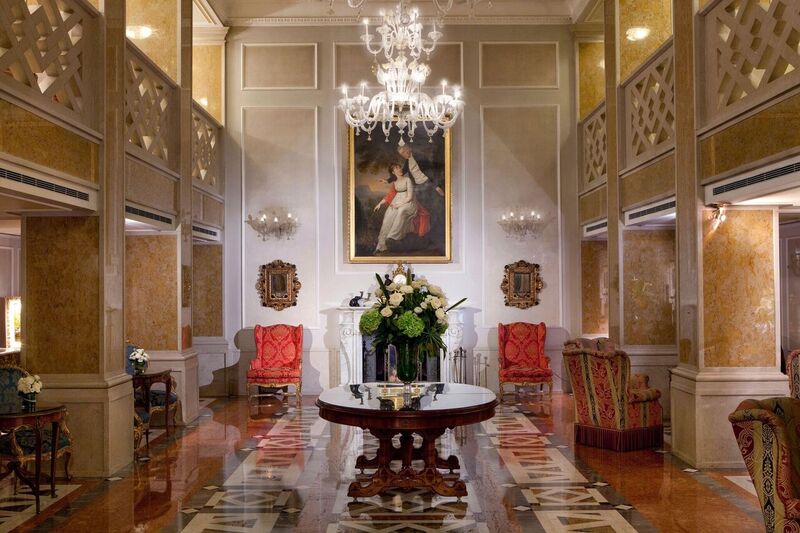 his
mark as a truly talented chef.
his
mark as a truly talented chef.
We started with a generous portion of
herb-marinated salmon served with sweet mango
and a creamy Greek yogurt. There is also fennel
escalope
caramelized with orange and plump Taggiasca
olives. Zennaro’s fresh pastas are extremely
well executed, simple and delicious. We shared
one tossed in a hearty beef ragù sprinkled
liberally with the best parmigiano cheese, as
well as a spaghetti “quadrati” lightly coated in
a sweet tomato sauce.
Entrees include a Venetian specialty of
fried shrimp, calamari, scampi and sand smelts
lightly coated, crisp and delightful with a
glass of white Venetian wine. Cuttlefish is
served in a rich sauce of the seafood, served
over a bed of creamy smooth white polenta. There
is also a fine selection of various prosciutti,
mortadella, bresaola, local salami, pickled ham
and many regional Italian cheeses.
Desserts
are just as impressive, specifically the
tiramisu, one of which is more than enough for
two.
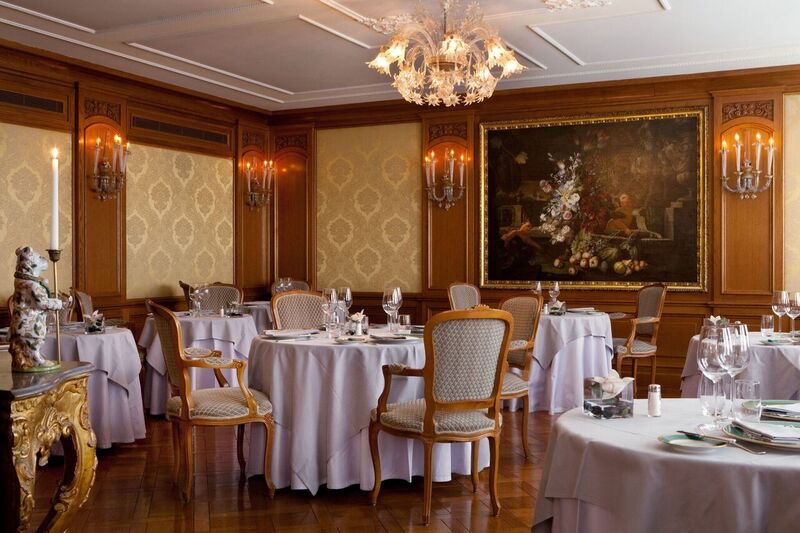 The
dining room (left)
is effusively gorgeous, with rich polished wood,
and brocade wallpaper, and a 17th century French
still life of food. All tables are draped with
heavy white table linens set with a small glass
vase of flowers. Plates and glassware are of the
finest quality, perfectly set with care on each
table. The
lighting is perfect, enhanced by a delicate
chandelier and lighted candles in silver scones.
The
dining room (left)
is effusively gorgeous, with rich polished wood,
and brocade wallpaper, and a 17th century French
still life of food. All tables are draped with
heavy white table linens set with a small glass
vase of flowers. Plates and glassware are of the
finest quality, perfectly set with care on each
table. The
lighting is perfect, enhanced by a delicate
chandelier and lighted candles in silver scones.
The
hotel is very convenient to St. Mark’s and the
Palazzo Ducale, Harry’s Bar and La Fenice Opera
House. At the moment it is offering a “Stay
Another Night” and breakfast is included in the
room rates.
I did not have a chance to stay at the
91-room hotel, including its extraordinary
suites, some large enough to host entire
weddings. The gracious General Manager Gianmatteo
Zampieri greeted us after our lunch and was kind
enough to tour us through the hotel, which could
be mistaken for a museum, considering the wealth
of artwork. His passion for the hotel is
mesmerizing as he tells the stories behind each
painting and the famous Marco Polo ballroom.
Baglioni Hotel Luna is as much worth a visit as
any of the city’s historic churches or
landmarks.
❖❖❖
By John Mariani
347-537-5786
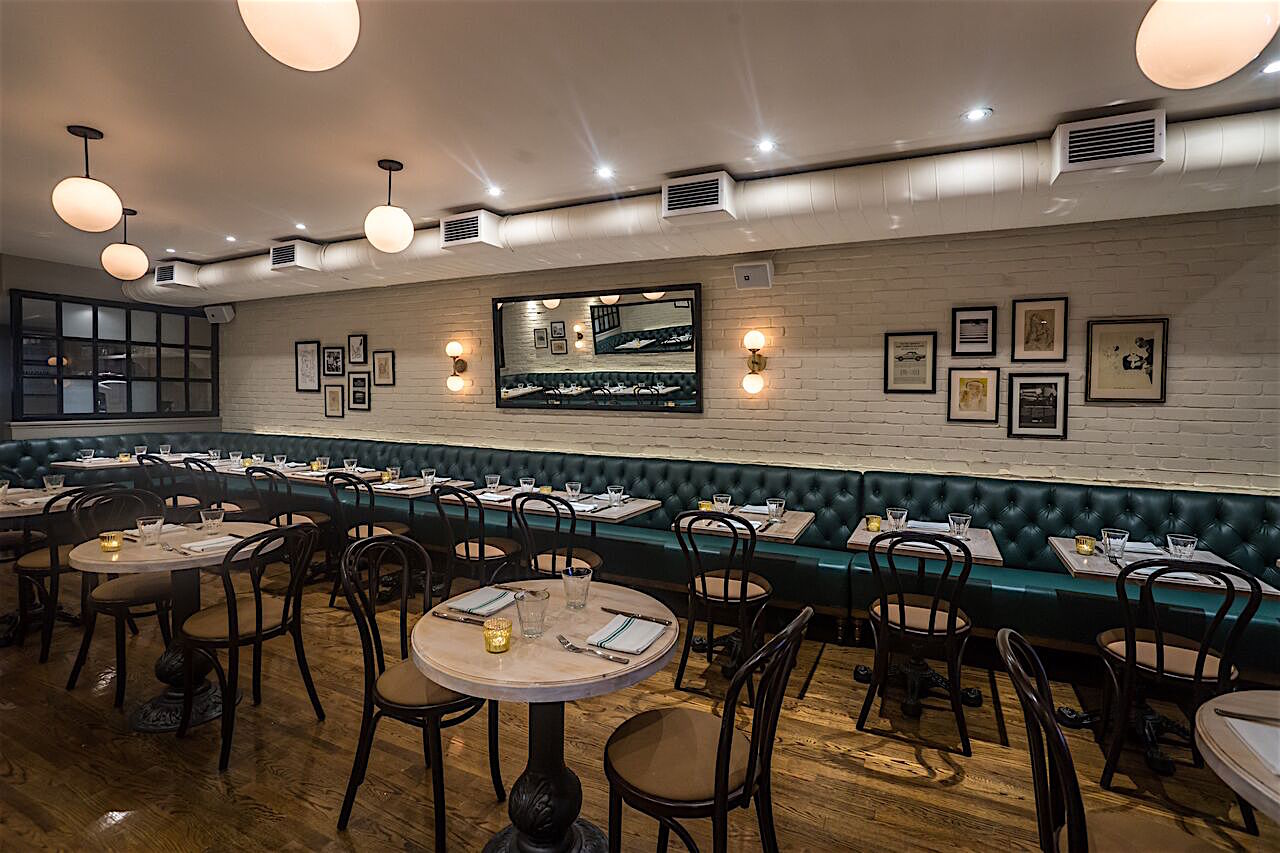 I’ve
known Francois Latapie for a good long while
now, dating back to the days when he was
mâitre d' at Le Cirque, then when he ran a
trendy restaurant on Miami Beach, and later
when he opened a very authentic French spot in
Greenwich Village named Lyon Bouchon Moderne
with the classic bistro dishes splendidly
prepared.
I’ve
known Francois Latapie for a good long while
now, dating back to the days when he was
mâitre d' at Le Cirque, then when he ran a
trendy restaurant on Miami Beach, and later
when he opened a very authentic French spot in
Greenwich Village named Lyon Bouchon Moderne
with the classic bistro dishes splendidly
prepared.
So I was very happy to hear
that he recently opened Little Frog on the Upper
East Side, where he’s already drawing a very
local crowd. (If they ever finish the Second
Avenue subway, maybe more people from elsewhere
will find their way there.) Latapie
(below)
has always been the epitome of French savoir
faire and bonhomie, with a great smile upon
greeting you and a way of seeming to be at  every
table at once, making sure everything is going
well and that you are having a good time.
While speaking with you he is also aware what is
going on five tables away.
every
table at once, making sure everything is going
well and that you are having a good time.
While speaking with you he is also aware what is
going on five tables away.
And, really, that’s the point
of a good bistro. The food must be rigorously
authentic, with wines to match, but the joie de
vivre of the room is paramount. You
don’t go to a bistro like Little Frog to eat an
ego-mad chef’s 20-course tasting menu; you go so
you can flop down on a comfortable banquette in
a clean, well-lighted place, have a nice
conversation with the owner, sip a simple wine,
and eat exactly what you want to eat. A bistro
is a place where even a solo diner can feel
completely relaxed and at home.
Little Frog is a handsome,
long slip of a white brick-walled room, seating
75, with a cheery bar up front, green tufted
banquettes, bentwood chairs and the requisite
tilted mirrors.
I’d prefer to see tablecloths than bare
wood, but somehow the room doesn’t get overly
loud when it’s full, thank heavens.
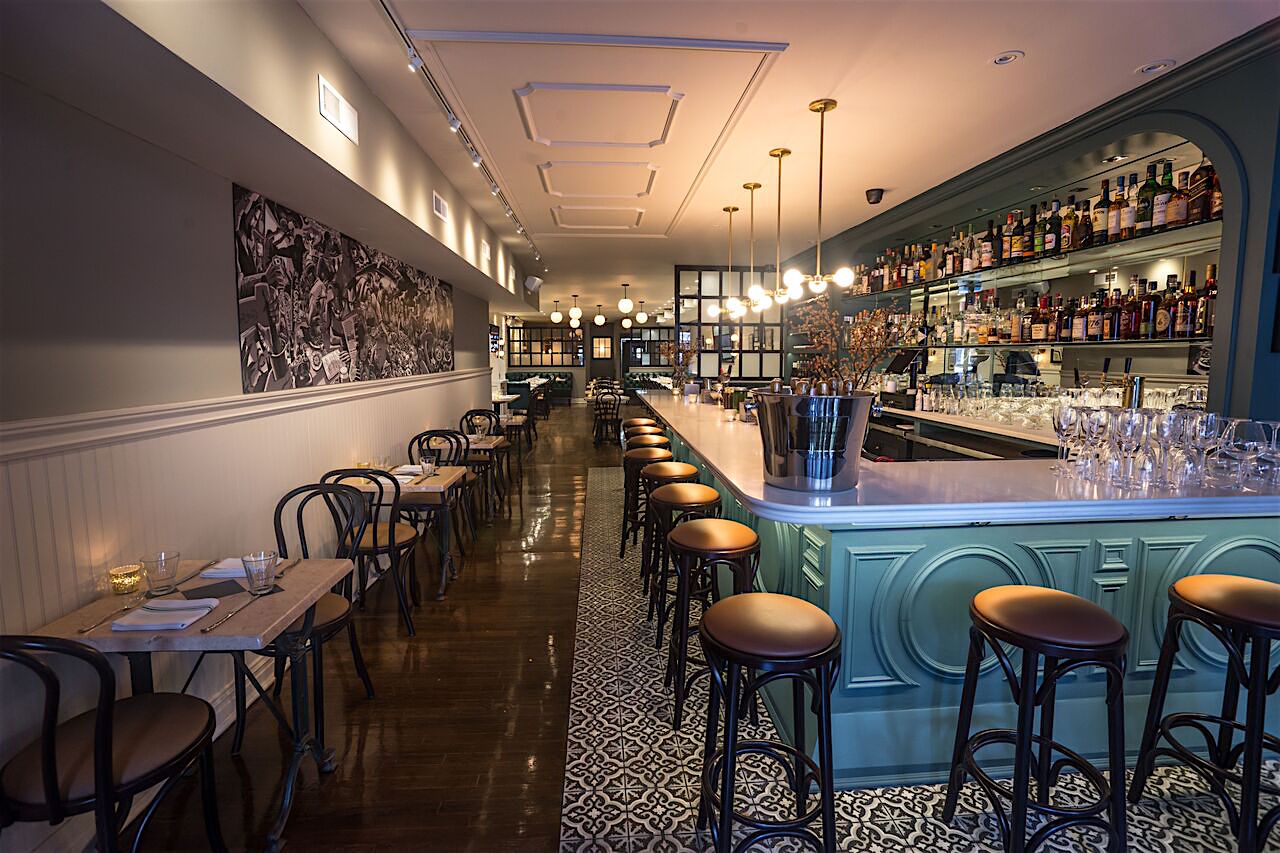 Chef
Xavier Monge, previously at Minetta Tavern,
proves that consistency in every dish is really
the key to this kind of cuisine. The grilled
octopus with celery, pine nuts, arugula,
pecorino and tapenade ($18) must always be this
tender and nicely crusted. The duck
liver foie gras parfait with griotte cherries
and grilled levain bread ($16)
must always be this creamy and flavorful. And,
of course, the onion soup gratinee ($12) must be
textbook perfect every time—a deep, dark
caramelized broth with abundant, sizzling
Gruyere cheese with a pliant, golden top. The
Little Frog salad ($15) is an assemblage of
haricots vert, baby head lettuce and aged
chèvre .
Chef
Xavier Monge, previously at Minetta Tavern,
proves that consistency in every dish is really
the key to this kind of cuisine. The grilled
octopus with celery, pine nuts, arugula,
pecorino and tapenade ($18) must always be this
tender and nicely crusted. The duck
liver foie gras parfait with griotte cherries
and grilled levain bread ($16)
must always be this creamy and flavorful. And,
of course, the onion soup gratinee ($12) must be
textbook perfect every time—a deep, dark
caramelized broth with abundant, sizzling
Gruyere cheese with a pliant, golden top. The
Little Frog salad ($15) is an assemblage of
haricots vert, baby head lettuce and aged
chèvre .
Coq au
vin is often made with a lackluster white 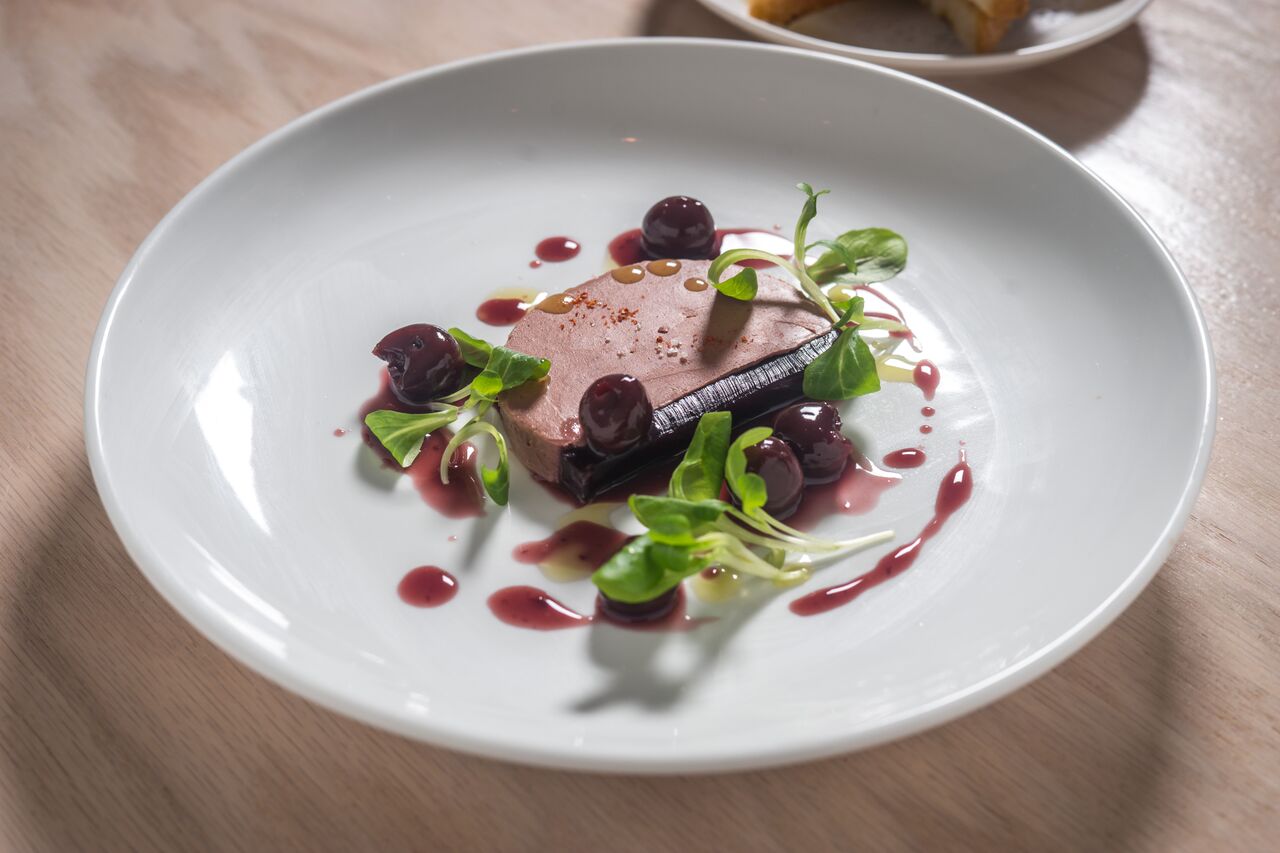 wine,
when red is far more traditional, and here the
dark meat of the bird is truly infused with a
fruity, tannic red wine that also soaks into the
carrots and bacon, served with buttered mashed
potatoes ($26). Côte de porc ($29)
comes as a very tender, rosy Heritage County
pork chop with lady apple and jus cassé,
and Scottish salmon is cooked quickly on the
heated plancha ($29), with eggplant caviar,
tomato, grilled scallions and aged balsamic
vinegar to embolden the subtle flavor of the
fish.
wine,
when red is far more traditional, and here the
dark meat of the bird is truly infused with a
fruity, tannic red wine that also soaks into the
carrots and bacon, served with buttered mashed
potatoes ($26). Côte de porc ($29)
comes as a very tender, rosy Heritage County
pork chop with lady apple and jus cassé,
and Scottish salmon is cooked quickly on the
heated plancha ($29), with eggplant caviar,
tomato, grilled scallions and aged balsamic
vinegar to embolden the subtle flavor of the
fish.
And then there’s good old
steak au
poivre ($36), which absolutely must
have the right chewiness and the right amount of
black peppercorns crushed into the meat and the
sauce, with a brandy reduction and
impeccably golden French fries in a paper cone.
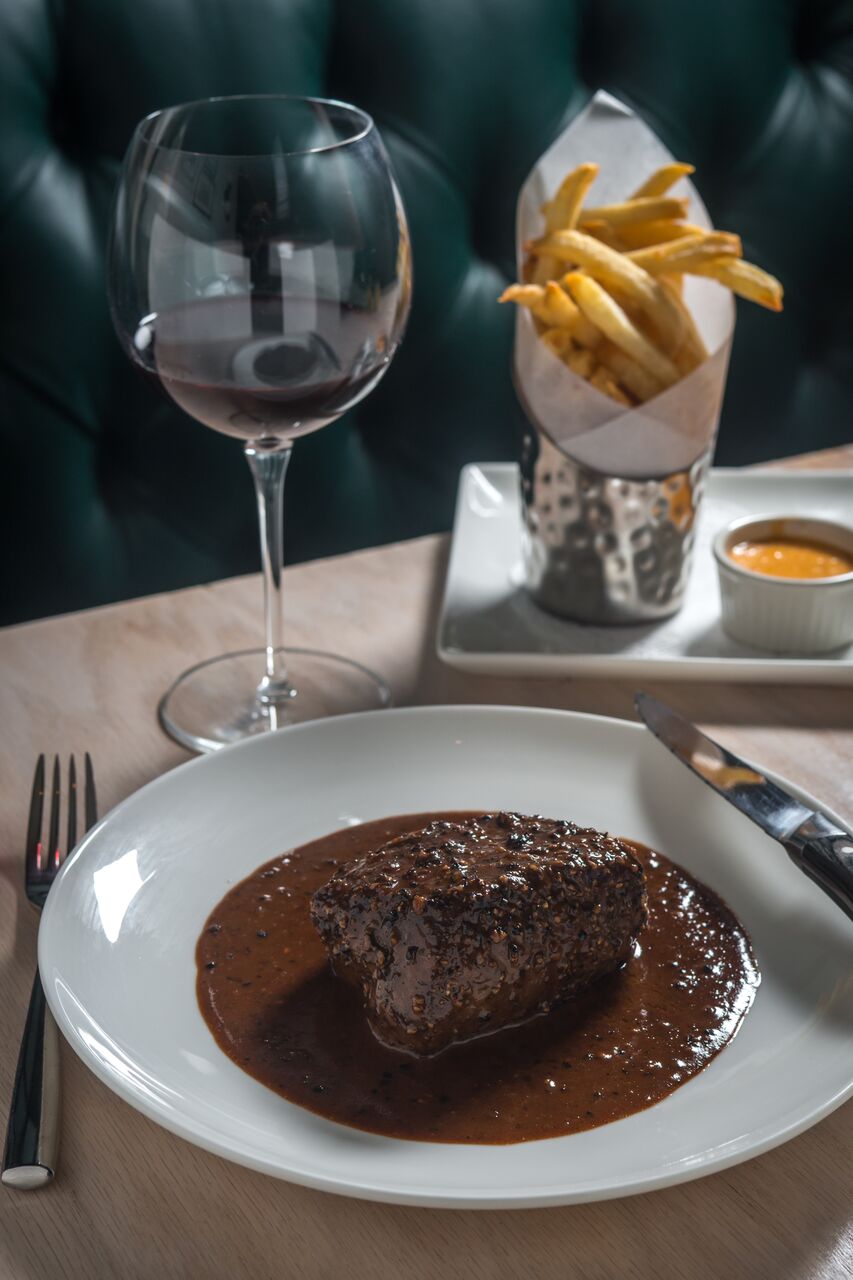 The desserts stay
within the beloved canon of floating island in a
vanilla-rich rich crème anglaise, and a deep
dark chocolate pot de crème (both
$12). Only a panna cotta was lacking in
flavor that night.
The desserts stay
within the beloved canon of floating island in a
vanilla-rich rich crème anglaise, and a deep
dark chocolate pot de crème (both
$12). Only a panna cotta was lacking in
flavor that night.
Bistros should always have a
solid but compact wine list and Little Frog’s is
just that: About 50 good selections with
regional wines, mostly from France, but some
from Italy, Argentina and Austria. Mark
ups are high: A Serge Dagueneau et Filles 2015
Pouilly Fumé sells for $23 in a store; at Little
Frog it is $60; a Mercurey Maison Chanzu 2015
Clos Roy is $27 versus $79 here.
NYC has a good number of fine
little bistros already in place, but you can
never have too many, at least not when they are
as classic and well-run as Little Frog.
Open for dinner nightly, for brunch Sat. & Sun.
❖❖❖
FRANCIS FORD COPPOLA
By Brian Freedman
Photos by Chad Keig
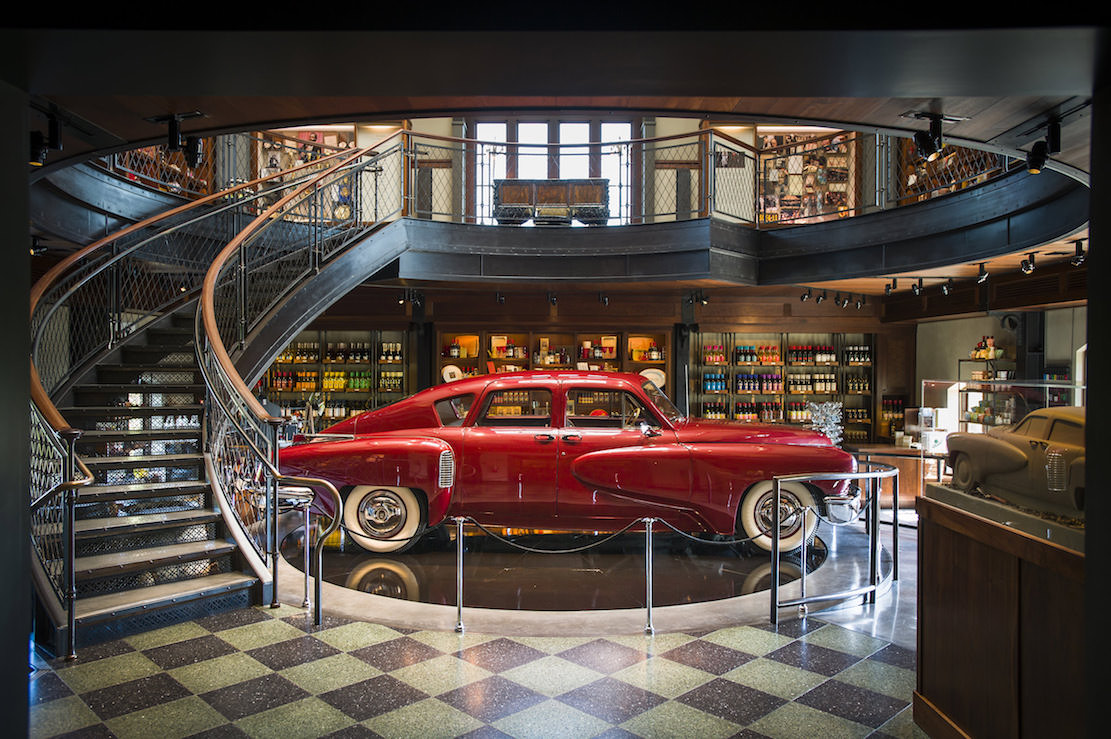
As
a rule, I read every press release that finds
its way to my inbox—with one exception: Wines
claiming some sort of affiliation with a
particular celebrity. Not all of them are
terrible, of course, but lately it seems as if
even D-list status is enough for the collective
population of our American pop-culture 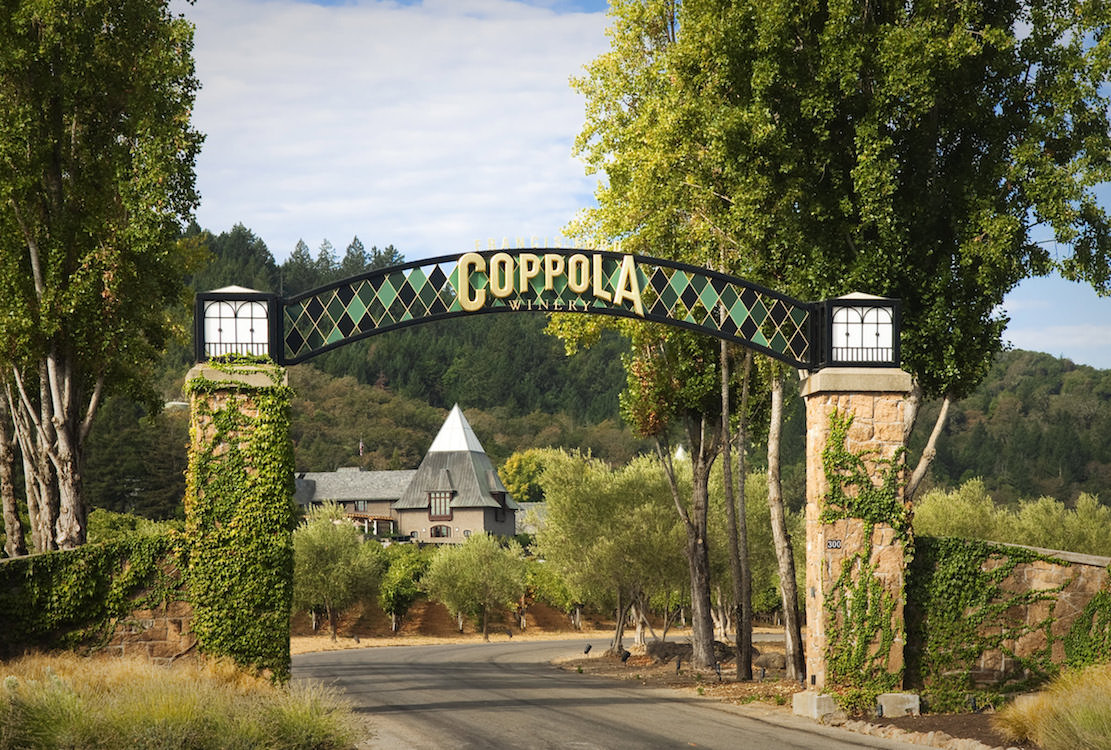 trash-bin
to cynically justify slapping their vaguely
familiar name on a bottle of plonk and hope that
that’s enough to sell it to the fans of their
show.
trash-bin
to cynically justify slapping their vaguely
familiar name on a bottle of plonk and hope that
that’s enough to sell it to the fans of their
show.
In general, it’s fair to say that appearing
on any of the “Real Housewives” franchises is,
shockingly, not the grape-juice equivalent of a
degree from the University of California at Davis
Department of Viticulture and Enology, and it’s
certainly no guarantee that the liquid in the
bottle bearing said housewife’s name will taste
like anything better than cough syrup mixed with a
bit of sugar.
But that
doesn’t mean that all celebrity wines are
soul-crushing; there are plenty of them that are
perfectly decent, and some even better than that. Then
there are the wines of Francis Ford Coppola, which
have, steadily over the course of the past four
decades, become among the most reliably well
crafted, easy-to-find, and pleasure-providing
bottlings on the market, regardless of producer.
Indeed, the team at Coppola has pulled off that
most difficult trick: The Coppola name is now just
as well known for excellent wine as it is for
film—no small feat, considering the fact that
Francis Ford Coppola made a little movie called
“The Godfather.”
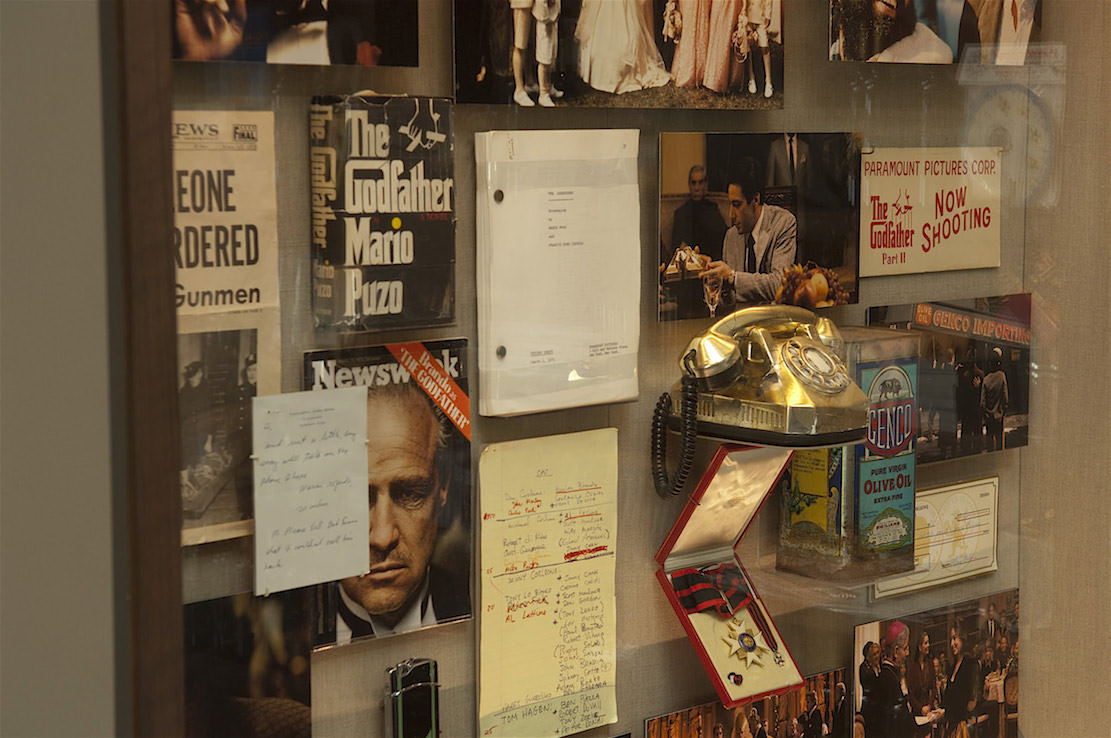 Coppola
and his wife, Eleanor, purchased the Niebaum
mansion and a sizable chunk of the legendary
Inglenook property in 1975, including 1,560 acres
of land. The first wine, Rubicon, was crafted in
1978, and released in 1985. Over the course of the
intervening decades, Coppola has worked with a
who’s who of consultants and winemakers (André
Tchelistcheff, Stéphane Derenoncourt, longtime
winemaker Scott McLeod) and expanded the
winemaking operations to now include nine
winemakers and six viticulturalists, who work with
fruit purchased
from other growers as well as with grapes that are
grown on Coppola’s own 220 blocks spread across 13
counties throughout California, including Napa,
Sonoma, Santa Barbara and Monterey.
Coppola
and his wife, Eleanor, purchased the Niebaum
mansion and a sizable chunk of the legendary
Inglenook property in 1975, including 1,560 acres
of land. The first wine, Rubicon, was crafted in
1978, and released in 1985. Over the course of the
intervening decades, Coppola has worked with a
who’s who of consultants and winemakers (André
Tchelistcheff, Stéphane Derenoncourt, longtime
winemaker Scott McLeod) and expanded the
winemaking operations to now include nine
winemakers and six viticulturalists, who work with
fruit purchased
from other growers as well as with grapes that are
grown on Coppola’s own 220 blocks spread across 13
counties throughout California, including Napa,
Sonoma, Santa Barbara and Monterey.
The result is a remarkable
tapestry of terroirs and micro-climates with which
the winemaking team can work to craft the wide
range of wines in the Coppola portfolio. I spent
several days with the Coppola  team in the Alexander
Valley this past summer, and came away more than
impressed by not just the scale of the operation,
but also by the attention to detail that is paid
to each and every one of the nearly two dozen
bottlings they produce, from the value-priced
Diamond series to the $89 Archimedes Cabernet
Sauvignon, which has earned critical praise
vintage after vintage.
team in the Alexander
Valley this past summer, and came away more than
impressed by not just the scale of the operation,
but also by the attention to detail that is paid
to each and every one of the nearly two dozen
bottlings they produce, from the value-priced
Diamond series to the $89 Archimedes Cabernet
Sauvignon, which has earned critical praise
vintage after vintage.
The 2013 is a subtle yet
powerful gem, with sage, floral pink peppercorn,
sweet currants, mocha, and cedar that can be
enjoyed now with a stint in the decanter, or held onto for the
next decade. Among the Diamond Series, I
particularly enjoyed the 2014 Merlot, with its
generous vanilla spice framing gulpable flavors of
blueberry and cobbler shell. These wines are
crafted from fruit grown in appellations across
the breadth of California, and the focus therefore
is on the character of the grape variety itself as
opposed to the terroir of their origins. From a
Quality-Price Ratio standpoint—they are
line-priced at under $20—they represent an
excellent option in the everyday category.
 A step more
specific in terroir expressivity are the
Director’s Cut wines, bottlings made from grapes
grown in specific AVAs within Sonoma County. The
Director’s Cut Chardonnay 2014 showcases generous fruit flavors and a
beautifully creamy texture that never sacrifices
liveliness and energy, with
a healthy dose of acidity slicing through all the
stone fruit and orange blossom richness. The
Director’s Cut Zinfandel is a quintessential Dry
Creek Valley bottling with its chocolate ganache,
blueberry and spice notes.
A step more
specific in terroir expressivity are the
Director’s Cut wines, bottlings made from grapes
grown in specific AVAs within Sonoma County. The
Director’s Cut Chardonnay 2014 showcases generous fruit flavors and a
beautifully creamy texture that never sacrifices
liveliness and energy, with
a healthy dose of acidity slicing through all the
stone fruit and orange blossom richness. The
Director’s Cut Zinfandel is a quintessential Dry
Creek Valley bottling with its chocolate ganache,
blueberry and spice notes.
Even
more tied to a specific patch of the planet is the
Reserve line of wines, each of which comes from a
single vineyard in Sonoma. The Reserve Pinot Noir
is from the justifiably venerated Dutton Ranch,
and the 2014 bottling is a spicy beauty, with
brambly berry fruit, forest floor notes, and
lingering acidity that keeps it all fresh. The
Reserve Syrah 2013—it’s 90% of that grape variety
perked up with 10% Viognier—showcases sweet and
spicy dark berry fruit as well as chocolate and an
unexpected note of charred kumquat.
The range of wines that Coppola
produces is little short  of
astounding. From the higher-priced bottlings like
Archimedes and Eleanor (the 2013 is a steal at
$65, a mineral- and spice-zipped blend of Syrah,
Petite Sirah, and Cabernet Sauvignon with notes of
blackberry, blueberry, toast, and tobacco) to the
Great Movies bottlings and the entirely separate
brand Virginia Dare Winery (I loved the Two
Arrowheads 2013 in particular, a Rhone-style blend
of Viognier and Roussanne with white peach, lemon
drop, and honeyed notes carried on a rich yet
lively frame), the wine empire that the Coppola
family has built is beyond impressive.
of
astounding. From the higher-priced bottlings like
Archimedes and Eleanor (the 2013 is a steal at
$65, a mineral- and spice-zipped blend of Syrah,
Petite Sirah, and Cabernet Sauvignon with notes of
blackberry, blueberry, toast, and tobacco) to the
Great Movies bottlings and the entirely separate
brand Virginia Dare Winery (I loved the Two
Arrowheads 2013 in particular, a Rhone-style blend
of Viognier and Roussanne with white peach, lemon
drop, and honeyed notes carried on a rich yet
lively frame), the wine empire that the Coppola
family has built is beyond impressive.
So, too, is the hospitality of
the brand: From Cafe Zoetrope in San Francisco and
Rustic Restaurant at the Geyserville winery to the
movie-set pool and cabins that are available to
rent (and which sell out very, very quickly each
year), Coppola has created that rarest of things:
A wine brand that was begun as a result of its
founder’s celebrity, but that has surpassed those
origins a thousand-fold and become a major player
in the world of wine in its own right. It’s an
amazing, delicious story, and a fascinating tale
of how one man has managed to make his name
helping to define not one but two quintessentially
American art forms: Movies that stand the test of
time and wines that express the stunning terroir
of California.
Someone
really should make a movie about it.
WASN'T KETCHUP-NESS A CHARACTER
IN "THE HUNGER GAMES"?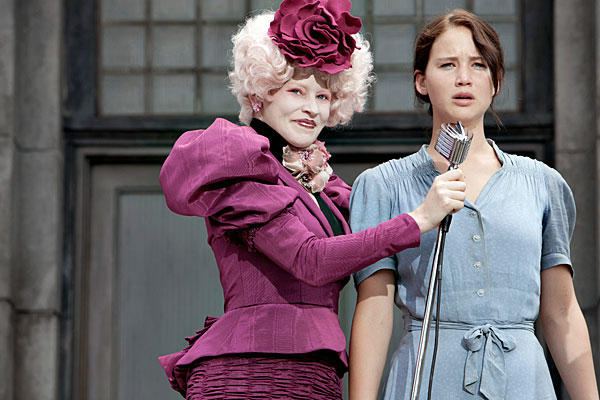
“Less
exciting was the Yolk and Swine, a two-egg
sandwich with barbecue-sauced bacon and cheddar on
a brioche bun. I just didn't like the ketchup-ness
of the liberally applied sweet sauce, which seemed
to tomato-up the whole thing. It made it hard to
tell if the bacon had much of a smoky
flavor.”--Debbi Snook, "Rebol," Cleveland Plain
Dealer ( 12/16/16)
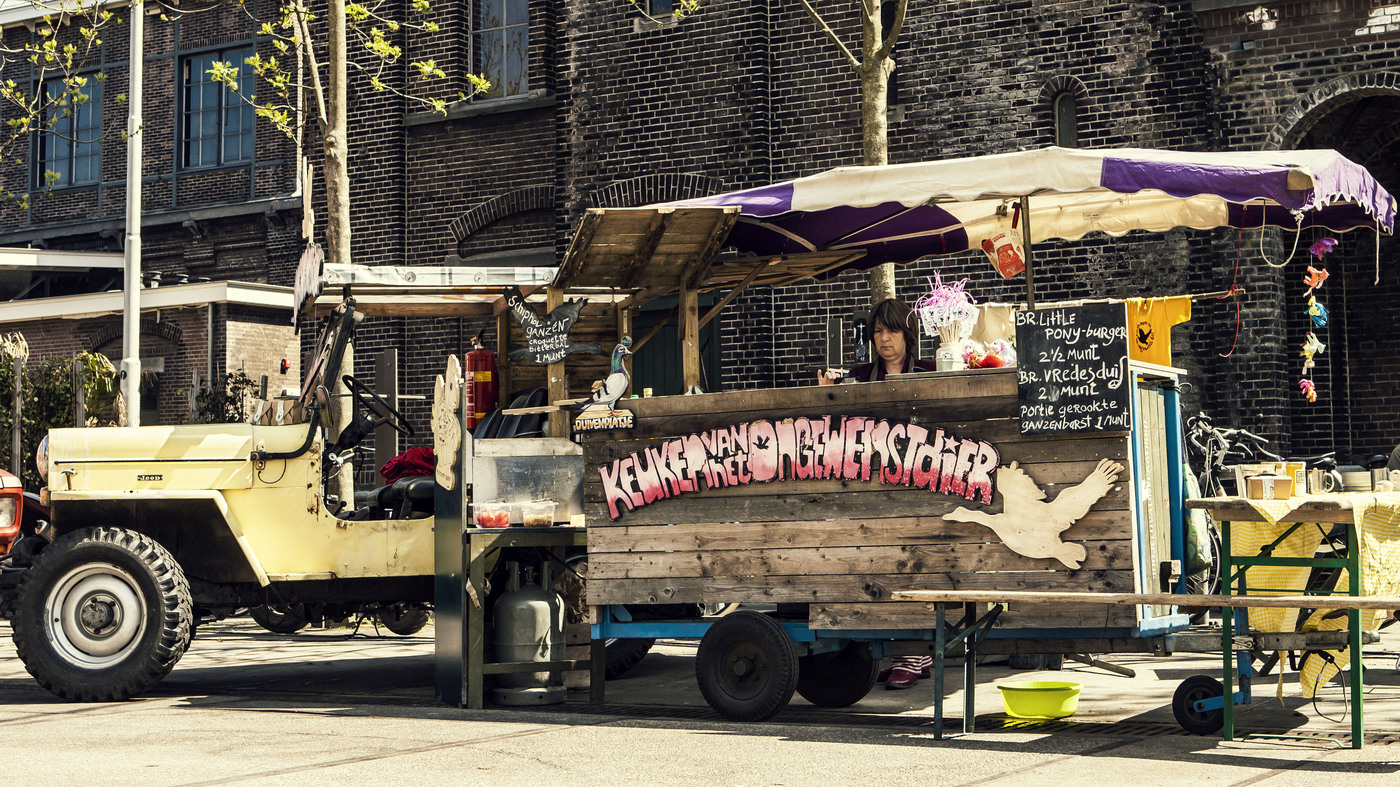 BY ALL MEANS,
BY ALL MEANS,
BRING THE
KIDS!
A food truck named the Unwanted Animal Kitchen (left) run by two artists in the Dutch city of Breda, is serving the “wild flavor” of animals otherwise doomed to die, like old horses, pigeons, canal crayfish, coots, rats and parakeets. Bambi Balls were early favorites, but the $18 “My Little Pony burger” has not sold well. Says co-owner Babbe Hengeveld, “People do feel bad about the idea of eating horse,” she told Vice. “For people to understand, you really have to explain to them clearly about the unwanted ponies and horse meat. When I’m cooking in the kitchen, I don’t always have time for this.” The ponies are sourced from Slagharen amusement park.
Any of John Mariani's books below may be ordered from amazon.com.
 The
Hound in Heaven (21st Century Lion Books)
is a novella, and for anyone who loves dogs,
Christmas, romance, inspiration, even the supernatural, I
hope you'll find this to be a treasured favorite.
The story concerns how, after a New England teacher,
his wife and their two daughters adopt a stray puppy found
in their barn in northern Maine, their lives seem full of
promise. But when tragedy strikes, their wonderful dog
Lazarus and the spirit of Christmas are the only things
that may bring his master back from the edge of
despair.
The
Hound in Heaven (21st Century Lion Books)
is a novella, and for anyone who loves dogs,
Christmas, romance, inspiration, even the supernatural, I
hope you'll find this to be a treasured favorite.
The story concerns how, after a New England teacher,
his wife and their two daughters adopt a stray puppy found
in their barn in northern Maine, their lives seem full of
promise. But when tragedy strikes, their wonderful dog
Lazarus and the spirit of Christmas are the only things
that may bring his master back from the edge of
despair. WATCH THE VIDEO!
“What a huge surprise turn this story took! I was completely stunned! I truly enjoyed this book and its message.” – Actress Ali MacGraw
“He had me at Page One. The amount of heart, human insight, soul searching, and deft literary strength that John Mariani pours into this airtight novella is vertigo-inducing. Perhaps ‘wow’ would be the best comment.” – James Dalessandro, author of Bohemian Heart and 1906.
“John Mariani’s Hound in Heaven starts with a well-painted portrayal of an American family, along with the requisite dog. A surprise event flips the action of the novel and captures us for a voyage leading to a hopeful and heart-warming message. A page turning, one sitting read, it’s the perfect antidote for the winter and promotion of holiday celebration.” – Ann Pearlman, author of The Christmas Cookie Club and A Gift for my Sister.
“John Mariani’s concise, achingly beautiful novella pulls a literary rabbit out of a hat – a mash-up of the cosmic and the intimate, the tragic and the heart-warming – a Christmas tale for all ages, and all faiths. Read it to your children, read it to yourself… but read it. Early and often. Highly recommended.” – Jay Bonansinga, New York Times bestselling author of Pinkerton’s War, The Sinking of The Eastland, and The Walking Dead: The Road To Woodbury.
“Amazing things happen when you open your heart to an animal. The Hound in Heaven delivers a powerful story of healing that is forged in the spiritual relationship between a man and his best friend. The book brings a message of hope that can enrich our images of family, love, and loss.” – Dr. Barbara Royal, author of The Royal Treatment.
 |
The Encyclopedia of American Food and Drink by John F. Mariani (Bloomsbury USA, $35) Modesty forbids me to praise my own new book, but let me proudly say that it is an extensive revision of the 4th edition that appeared more than a decade ago, before locavores, molecular cuisine, modernist cuisine, the Food Network and so much more, now included. Word origins have been completely updated, as have per capita consumption and production stats. Most important, for the first time since publication in the 1980s, the book includes more than 100 biographies of Americans who have changed the way we cook, eat and drink -- from Fannie Farmer and Julia Child to Robert Mondavi and Thomas Keller. "This book is amazing! It has entries for everything from `abalone' to `zwieback,' plus more than 500 recipes for classic American dishes and drinks."--Devra First, The Boston Globe. "Much needed in any kitchen library."--Bon Appetit. |
"Eating Italian will never be the same after reading John Mariani's entertaining and savory gastronomical history of the cuisine of Italy and how it won over appetites worldwide. . . . This book is such a tasteful narrative that it will literally make you hungry for Italian food and arouse your appetite for gastronomical history."--Don Oldenburg, USA Today. "Italian
restaurants--some good, some glitzy--far
outnumber their French rivals. Many of
these establishments are zestfully described
in How Italian Food Conquered the World, an
entertaining and fact-filled chronicle by
food-and-wine correspondent John F.
Mariani."--Aram Bakshian Jr., Wall Street
Journal.
"Equal parts
history, sociology, gastronomy, and just
plain fun, How Italian Food Conquered the
World tells the captivating and delicious
story of the (let's face it) everybody's
favorite cuisine with clarity, verve and
more than one surprise."--Colman Andrews,
editorial director of The Daily
Meal.com. "A fantastic and fascinating
read, covering everything from the influence
of Venice's spice trade to the impact of
Italian immigrants in America and the
evolution of alta cucina. This book will
serve as a terrific resource to anyone
interested in the real story of Italian
food."--Mary Ann Esposito, host of PBS-TV's
Ciao
Italia. "John Mariani has written the
definitive history of how Italians won their
way into our hearts, minds, and
stomachs. It's a story of pleasure over
pomp and taste over technique."--Danny Meyer,
owner of NYC restaurants Union Square
Cafe, The Modern, and Maialino.
|
 |
 |
 |
 |
 |
 |
 |
 |
 Everett Potter's Travel Report:
Everett Potter's Travel Report: 
 Eating Las Vegas
JOHN CURTAS has been covering the Las Vegas
food and restaurant scene since 1995. He is
the co-author of EATING LAS VEGAS – The 50
Essential Restaurants (the fourth
edition of which will be published in early
2016), as well as the author of the Eating Las
Vegas web site: www.eatinglasvegas.
He can also be seen every Friday morning as
the “resident foodie” for Wake Up With the
Wagners on KSNV TV (NBC) Channel 3 in
Las Vegas.
Eating Las Vegas
JOHN CURTAS has been covering the Las Vegas
food and restaurant scene since 1995. He is
the co-author of EATING LAS VEGAS – The 50
Essential Restaurants (the fourth
edition of which will be published in early
2016), as well as the author of the Eating Las
Vegas web site: www.eatinglasvegas.
He can also be seen every Friday morning as
the “resident foodie” for Wake Up With the
Wagners on KSNV TV (NBC) Channel 3 in
Las Vegas.

MARIANI'S VIRTUAL GOURMET
NEWSLETTER is published weekly. Editor/Publisher: John
Mariani.
Editor: Walter Bagley. Contributing Writers: Christopher Mariani,
Robert Mariani, Misha Mariani, John A. Curtas, Geoff Kalish, Mort
Hochstein, and
Brian Freedman. Contributing Photographers: Galina
Dargery. Technical Advisor: Gerry McLoughlin.
To un-subscribe from this newsletter,click here.
© copyright John Mariani 2016

